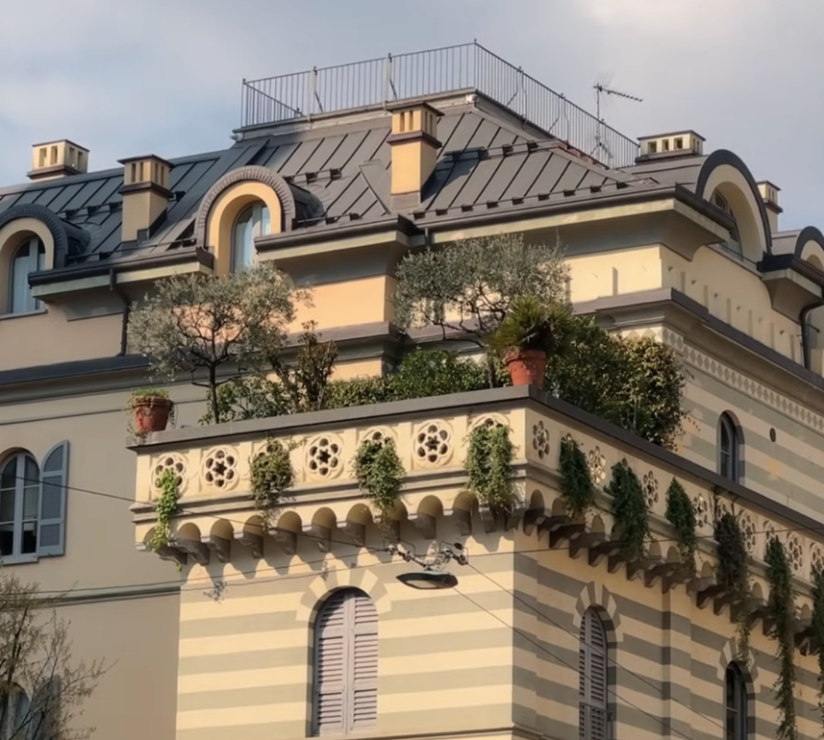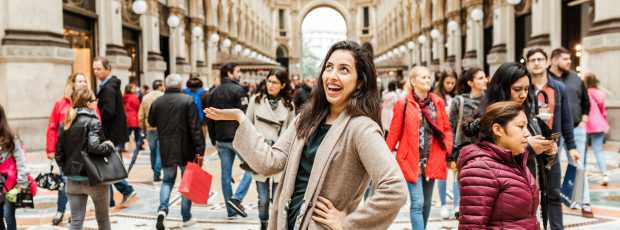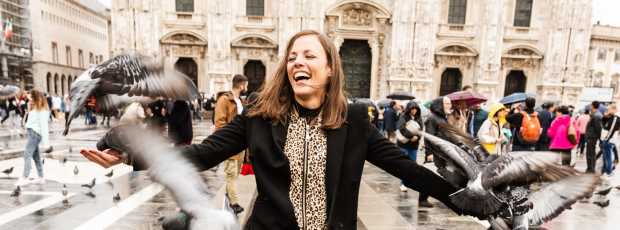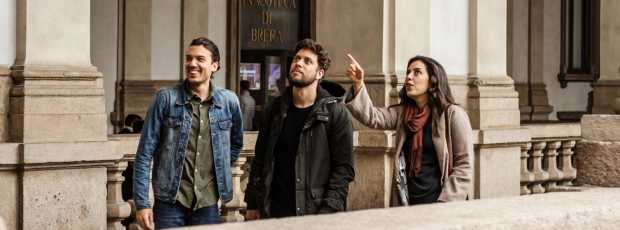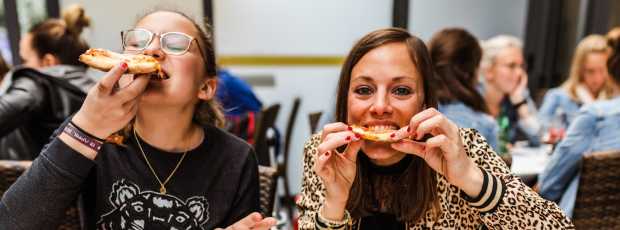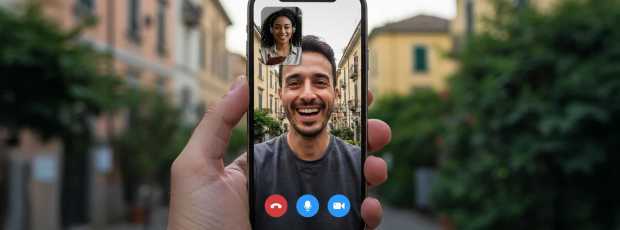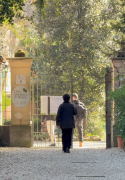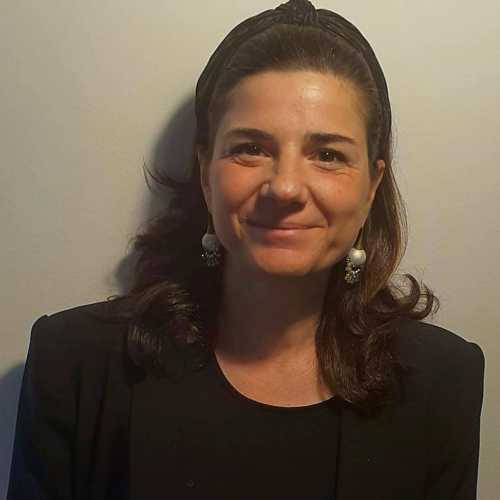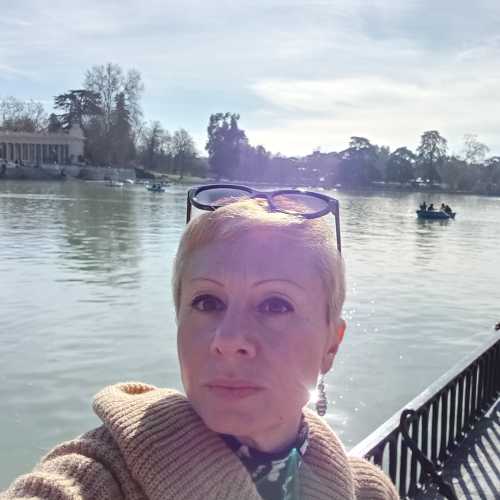Explore Milan Like a Local on a Private Tour
Real neighborhoods, local hangouts, your pace
Table Of Contents
- Which Neighborhoods Are Non-Negotiable in Milan?
- Iconic Neighborhoods With A Local Lens
- Where Is Milan's Creative Energy Right Now?
- Foodie And Market Neighborhoods
- Relaxing Family-Friendly Corners
- Where Does Milan Go After Dark?
- Overrated Areas, With Smarter Ways to See Them
- Where Should You Stay in Milan?
- Practical Tips For Routes, Access, And Day Trips
- Frequently Asked Questions About Milan Neighborhoods
- Where Your Milan Story Begins
I'm Giulia, and I measure Milan experiences as much in espresso cups as in city blocks. Every neighborhood has its own café where the crema comes out just right, and that's usually where I start to understand its character.
When friends ask how to see the city through local eyes, I point them toward authentic things to do in Milan that don't follow guidebooks.

Duomo di Milano at dawn with empty piazza and soft golden light
Each of Milan's neighborhoods carries its own rhythm. From the fashion district's polished elegance to Ortica's street art corridors, I have watched this city evolve while keeping its essential character.
Whether you stay in Milan for three days or three weeks, understanding these distinct pockets helps you move beyond tourist checklists into authentic city life.
This guide maps both famous districts and locally loved corners that reveal Milan's true personality. Also, public transport makes the best day trips from Milan easy.
Como S. Giovanni in 40 minutes from Milano Centrale. Desenzano del Garda in 50 to 90 minutes, depending on the train. But first, let me show you where elegance lives in the Milan neighborhoods that shaped me.
Which Neighborhoods Are Non-Negotiable in Milan?
Start in Centro Storico, where the Duomo rises over the Galleria Vittorio Emanuele II, and nineteenth-century glass and mosaics set the daily rhythm. Drift to the Brera district, with cobblestone streets, the Pinacoteca di Brera, and cafés that spill into antique lanes.
Follow the canals of Navigli during aperitivo as markets unfurl beside the water, then look north to Porta Nuova, where modern skyscrapers ring the Vertical Forest.
Cross the Quadrilatero della Moda for ritual window shopping and luxury boutiques in quiet courtyards, and you will understand why these are among the city's main attractions and the best Milan neighborhoods many first-timers choose as a base.
Snippet takeaway: These five areas give you Milan's essential character, from Gothic grandeur to contemporary design, all connected by efficient public transport.
Experiences Created by Locals, Just for You
See the city through the eyes of the people who call it home.
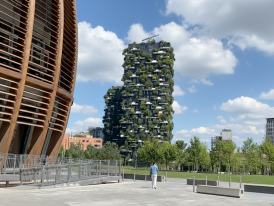
Bosco Verticale towers with pedestrian plaza and greenery
Iconic Neighborhoods With A Local Lens
This is where first-timers visit Milan and fall in love, and it is where regulars keep returning. Start in the centro storico for the Duomo and the Galleria Vittorio Emanuele II, then wander to the Brera district for art galleries and cobblestone calm.
Cross into the fashion district for window shopping and luxury boutiques, all within easy walking distance of cafés and courtyards.
Follow public transport to Porta Nuova for the Vertical Forest and modern skyscrapers that frame today's skyline.
Centro Storico: Historic Center Of Milan Life
Walking through Centro Storico feels like stepping into Milan's living museum. The Gothic cathedral dominates Piazza del Duomo, while Galleria Vittorio Emanuele II showcases nineteenth-century elegance with its glass dome and mosaic floors. This historic center represents one of Milan's most treasured cultural attractions.
Sforza Castle anchors the northern edge, surrounded by parkland where families picnic on sunny afternoons. Pedestrian Via Dante links Piazzale Cordusio toward Castello Sforzesco, steps from the Duomo, lined with shops and cafés.
The historic building facades tell centuries of stories while modern cafés serve the crowds heading to the city's main attractions.
This neighborhood offers easy access to Milan's main sights, but expect crowds during peak tourist seasons and higher prices than residential areas. The area transforms after sunset when day-trippers depart and locals reclaim their evening aperitivo spots. Morning espresso here costs more than in residential areas, but watching the city wake up from a café table by the Duomo makes the premium worthwhile.
Accessibility note: The Duomo piazza is flat and step-free, though cobblestones can challenge strollers. Galleria floors are smooth marble. Save Santa Maria delle Grazie for a separate Magenta stop and book well in advance.
Snippet takeaway: Centro Storico delivers iconic Milan with tourist intensity, best experienced early morning or after dark when the crowds thin.
Quadrilatero della Moda: Fashion District Excellence
The golden rectangle between Via Montenapoleone and Via della Spiga creates Milan's most exclusive shopping corridor. Window shopping along these streets feels like browsing a curated museum of contemporary style, showcasing luxury boutiques and upscale shops that define international fashion.
I love this district's dual personality. By day, it bustles with international shoppers and business meetings.
After 8 PM, the luxury boutiques close their doors and the neighborhood becomes surprisingly peaceful. Hidden courtyards reveal intimate spaces where fashion insiders gather for quiet conversations.
I still find myself pausing at certain shop windows here. Not always to buy, but to admire how Milan stages elegance as effortlessly as breathing. Even after years, window shopping in this district feels like walking through a living gallery.
Portrait Milano exemplifies the district's understatement. Set in the restored former Archiepiscopal Seminary off Corso Venezia, it places you close to many flagship boutiques in the Quadrilatero.
Price note: Expect premium prices for everything here, from coffee (€3 to €5) to accommodations, but the experience justifies the cost if fashion is your priority.
Snippet takeaway: The fashion district shows Milan's global style credentials, most peaceful after hours when you can appreciate the architecture without the shopping crowds.
Brera district perfectly balances tourist appeal with authentic local life.
Brera District: Art And Cobblestone Charm
Brera's cobblestone streets create Milan's most photogenic neighborhood. The Pinacoteca di Brera houses masterpieces, while surrounding galleries showcase contemporary works from emerging artists. This district perfectly balances tourist appeal with authentic local life.
Via Brera itself buzzes with antique shops, independent bookstores, and cafés where art students debate late into the evening.
The antiques market draws collectors on the third Sunday of each month, especially around Via Fiori Chiari and nearby streets. Architecture lovers appreciate Brera's mix of medieval buildings and Liberty-style facades that create constantly changing street compositions.
When I slip into Brera on a weekday afternoon, I love watching art students spill into cafés, sketchbooks open, espresso cups balancing precariously beside them. It's a reminder that beauty here isn't confined to museums. It lives in the everyday rhythm of the neighborhood.
Residents shop at the morning market in Via San Marco, then enjoy leisurely strolls in the afternoons with aperitivo at bars that have served the same families for generations. This historic center area has several museums and cultural institutions close to each other.
Accessibility note: Cobblestones throughout can be bumpy for wheels, but most cafés have step-free entrances and the pedestrian zones are traffic-free.
Snippet takeaway: Brera gives you Milan's artistic soul with working galleries and student energy, not just museum pieces behind glass.
Don’t Just Visit Milan. Feel Part of It.
Locals share their city as they live it, so even a few hours can feel like you truly belong.Navigli: Canal Culture And Evening Energy
Milan's canal district comes alive as the sun sets. The waterways reflect golden light while locals gather along the banks for the aperitivo ritual that defines Milanese social life. This neighborhood offers some of Milan's highlights for evening entertainment.
Naviglio Grande and Naviglio Pavese create two distinct corridors. The Grande side buzzes with restaurants and bars, while Pavese maintains a slightly calmer atmosphere with intimate trattorias. Weekend antique markets draw collectors searching for vintage furniture and curiosities.
This area represents essential city life for young Milanese, though expect crowds on Friday and Saturday evenings when the entire city descends for drinks and dinner.
During April's Milan Design Week (Fuorisalone), Navigli hosts pop-ups and installations by local artisans and makers.
Outside Design Week, it's a lively bar and restaurant scene rather than a monthly design program. On the last Sunday of each month, the Naviglio Grande antiques market lines the canal for nearly 2 km.
Price note: Mid-range prices for aperitivo (€8 to €15 with snacks), with plenty of budget-friendly options on side streets. Arrive before 7 PM for the best deals.
Etiquette tip: Order at least one drink if you're going to graze the aperitivo buffet. Standing along the canal is free, but respect the businesses that create the atmosphere.
Snippet takeaway: Navigli delivers Milan's aperitivo culture at its most vibrant, best experienced on weeknights when you can actually move and breathe.
Imagine Experiencing Navigli for Real
A local can show you the vibe, flavors, and hidden gems up close.
Porta Nuova: Modern Skyscrapers And Vertical Forest Living
Porta Nuova represents Milan's bold leap into the future. The vertical forest towers of Bosco Verticale create an iconic skyline that architecture lovers photograph constantly. This district showcases contemporary architecture at its most ambitious, with luxury apartments rising between established neighborhoods.
The area around Porta Garibaldi station buzzes with business energy during weekdays, transforming into a sophisticated evening destination. Modern design cafés serve excellent espresso while offering views of these architectural marvels. Green spaces between the towers provide respite from the urban intensity.
Porta Nuova connects seamlessly to other neighborhoods via public transport, making it ideal for business travelers who appreciate prime location advantages. The contrast between these modern skyscrapers and Milan's historic center creates fascinating juxtapositions that define contemporary Italian urban planning.
Even here, amid the glass towers, I catch the smell of fresh focaccia drifting from a corner bakery. Proof Milan never forgets its roots, even while reaching skyward.
Accessibility note: The entire district was built recently with accessibility in mind. Wide sidewalks, step-free plazas, and modern elevators throughout.
Snippet takeaway: Porta Nuova shows where Milan is heading architecturally, with green towers and business polish that still makes room for neighborhood bakeries.
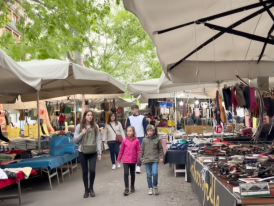
Flea market and stalls in Via Padova
Where Is Milan's Creative Energy Right Now?
These neighborhoods offer unique character and studio energy just outside the city center. Public transport gets you there in minutes, then the streets open into murals, maker studios, and student hangouts with local energy.
Expect art galleries, indie venues, and street food stalls that keep the energy high from afternoon to late night.
Once you arrive, most highlights are close enough to walk to, and the pace feels local even when Design Week brings extra buzz.
Ortica And Lambrate: Street Art Meets Maker Culture
Twenty minutes east of central Milan, Ortica unfolds like an open-air gallery. Murals cover warehouse walls and underpass columns, creating one of Europe's most vibrant street art corridors that showcase the city's creative evolution.
I discovered this area through friends who moved their design studios here for affordable rent and creative energy. Former industrial spaces now house artisan workshops, independent galleries, and weekend markets selling everything from vintage clothing to artisanal soap.
Lambrate, just north of Ortica, pulses with similar energy but maintains its own distinct character.
The area still has creative pockets, while major Design Week installations now appear in other districts. Simple trattorias serve honest Italian cuisine without tourist markup.
Price note: This is where Milan gets affordable. Espresso runs €1 to €1.50, full meals €10 to €20, and the street art is free.
Snippet takeaway: Ortica and Lambrate show Milan's maker culture without polish or pretense, where creativity happens in working studios rather than white-cube galleries.
Curious What You Won’t Find Online About Milan's Art Scene?
Discover the side only locals talk about.
Dergano And Bovisa: Student Studios And Quiet Squares
North of Porta Garibaldi, these neighborhoods feel like secret villages within the city. Students, especially from Politecnico di Milano's Bovisa campuses, fill cafés and bars with youthful energy. Bocconi's main campus sits south of here near Porta Romana and Navigli.
Dergano's residential streets hide tiny squares where elderly residents play cards while children kick footballs against medieval church walls. Modern design cafés serve excellent espresso alongside co-working spaces that blur the line between work and social life.
Bovisa maintains its working-class roots while embracing creative newcomers. Former factory buildings now contain artist studios and experimental galleries.
From nearby stations, including Milano Bovisa and Garibaldi, trains provide quick access to Lake Como for weekend escapes, while new apartments rise along the edges of these authentic neighborhoods.
Snippet takeaway: Dergano and Bovisa deliver village calm with student energy, perfect for travelers who want residential Milan without giving up urban conveniences.
NoLo: Multicultural Markets And Creative Venues
NoLo (North of Loreto) pulses with multicultural energy that reflects modern Milan's diversity. Independent venues host everything from jazz concerts to poetry readings in converted shops and basement spaces.
Local establishments pour natural wines alongside craft beers from microbreweries that represent Milan's evolving drink culture.
Regular street markets and stalls along and around Via Padova turn the area into a colorful bazaar where multiple languages mix while vendors sell fresh vegetables, spices, and household goods.
Young professionals increasingly choose NoLo for its authentic character and easy access to both central Milan and other neighborhoods.
Price note: NoLo offers Milan's best value. Accommodations run 30 to 50 percent less than the center, with equally good public transport access.
Snippet takeaway: NoLo shows Milan's multicultural present and future, where Pakistani bakeries and Ethiopian coffee ceremonies sit comfortably beside traditional Italian bars.
Foodie And Market Neighborhoods
Each neighborhood offers exceptional culinary experiences that reflect local character and the diverse range of influences shaping contemporary Milan. In Lambrate, family-run trattorias serve traditional risotto alla Milanese alongside contemporary interpretations that young chefs create in tiny kitchens.
NoLo's street food stalls expand Milan's palate with Pakistani, Chinese, and Peruvian flavors. Egyptian bakeries sell fresh bread while Ethiopian restaurants serve coffee ceremonies that last for hours.
These multicultural influences create food experiences that go far beyond traditional Italian cuisine. Exploring what to eat in Milan means venturing into these neighborhoods where the city's palate is still evolving.
The Quadrilatero conceals intimate spaces where sommeliers pour rare Lombard vintages alongside carefully selected cheeses. These places require insider knowledge, as they rarely advertise their existence to the general public.
Snippet takeaway: Milan's food scene lives in its neighborhoods, from Quadrilatero wine rooms to NoLo street stalls, each area adding its own flavor to the city's evolving palate.
Hungry to Try Milan's Delicious Food Yourself?
Taste and explore the flavors locals actually love.

Porta Romana street filled with happy visitors
Relaxing Family-Friendly Corners
These neighborhoods slow the pace without moving far from the city center. You get parks, canals, and safe green spaces where children can play. Public transport offers easy access, and most daily needs sit in walking distance. They suit families who want local city life with quiet evenings.
Gorla And Martesana Canal: Green Spaces And Family Life
Following the Martesana canal northeast reveals Milan's most family-friendly area. Tree-lined towpaths stretch for kilometers, perfect for morning runs or evening bicycle rides through green spaces that provide essential breathing room in this urban environment.
Gorla village sits like a small town within the larger city. Pocket parks provide green spaces where local families gather for weekend picnics. The weekly market sells fresh produce from nearby farms while historic buildings house cultural institutions that organize intimate concerts and art exhibitions.
About 10 to 15 minutes by metro from Stazione Centrale with one change at Loreto, yet it feels worlds away from the city center. This area offers respite from Milan's urban intensity while maintaining the community connections that make city life meaningful for families with children.
Accessibility note: The canal towpaths are flat, paved, and perfect for strollers. Playgrounds throughout have accessible equipment.
Snippet takeaway: Gorla and the Martesana give families breathing room with canal paths and village squares, connected to the center but worlds away in atmosphere.
Maggiolina And Villaggio dei Giornalisti: Architectural Surprises
These northern neighborhoods surprise visitors with unexpected architecture and a village-like atmosphere. Garden-lined streets wind between Liberty villas and modernist experiments that challenge conventional ideas about urban living.
The famous "igloo houses" in Maggiolina's Villaggio dei Giornalisti are post-war experiments from the late 1940s to the 1950s. They are quirky, curved dwellings that showcase bold small-scale residential design, though they weren't specifically built for journalists despite the neighborhood name.
Architecture lovers spend hours photographing the geometric patterns and studying how modernist principles created these unique neighborhoods. I still smile when I pass the igloo houses. They look like children's sketches made real, a whimsical surprise in a city often defined by elegance and order.
Small cafés serve the design community that has discovered these quiet streets, offering prime location advantages with residential tranquility.
Snippet takeaway: Maggiolina's igloo houses prove Milan embraces architectural experiments, giving families quirky charm alongside Liberty elegance in peaceful residential streets.
Porta Romana: Emerging Art District And Creative Energy
South of the city center, Porta Romana pulses with creative energy, transforming this former industrial area into one of Milan's most exciting cultural destinations. Art galleries occupy former warehouses, while new restaurants serve innovative Italian cuisine alongside traditional favorites.
This neighborhood offers excellent value for travelers seeking authentic experiences without tourist crowds. Porta Romana's neighborhood markets sell fresh produce, while independent venues host jazz concerts and experimental theater.
Young professionals increasingly choose this area for its distinct character and easy access to central attractions.
The Porta Romana area benefits from excellent public transport connections while maintaining reasonable prices that make long-term stays feasible. Historic building conversions create interesting architectural contrasts between industrial heritage and contemporary design interventions.
I've lost count of how many gallery openings I've attended in hidden Porta Romana courtyards. The kind where the prosecco flows, and you end up debating art with someone who might just be the next big Milanese name. This is where the city whispers about its future.
Price note: Mid-range overall. Accommodations and meals cost 20 to 30 percent less than Centro Storico with equally good transport links.
Snippet takeaway: Porta Romana balances emerging gallery scenes with residential authenticity, offering better value and fewer crowds than central districts.
Milan's Not Just a Place on a List
Experience it through hidden corners and stories most visitors miss.
Where Does Milan Go After Dark?
Night falls and Milan switches tempo. Navigli hums along the canals at blue hour while NoLo keeps things intimate in basement rooms and pocket bars. Lambrate draws jazz lovers and young crews who chase small stages and late encores.
Porta Venezia blends wine bars and Liberty facades with LGBTQ-friendly energy. Public transport offers easy access between these areas, and most spots are nearby once you arrive. For a deep dive into evening options, explore our guide to things to do in Milan at night.
NoLo's establishments stay open late for conversations between neighbors who've known each other for decades alongside newcomers drawn by the neighborhood's evolving character. Jazz clubs in Lambrate host international musicians in intimate venues where everyone sits close enough to see the performers' expressions.
Etiquette tip: Milan's nightlife runs later than you think. Aperitivo starts at 6 PM, dinner rarely before 8:30 PM, and bars fill after 10 PM. Dress well, even for casual spots.
Snippet takeaway: Milan's nightlife lives in its neighborhoods rather than a single district, from Navigli's canal crowds to NoLo's basement jazz, each area offering its own after-dark personality.
Beyond the Milan Checklist
Discover the city guidebooks don’t cover with a local by your side.

da Vinci's Last Supper
Overrated Areas, With Smarter Ways to See Them
Some places are worth seeing with better timing and a lighter touch. I still visit the big names, yet I plan my moments so the city feels generous rather than crowded. These swaps keep the city center magic while opening doors to local life.
Duomo And Galleria Vittorio Emanuele II
Keep: The architecture is genuinely spectacular and the Duomo roof walk offers unmatched city views.
Tweak: Visit before 8:30 AM or after 9 PM when tour groups have dispersed and the light is softer.
Alternative: Combine a quick center visit with longer time in nearby Brera for similar grandeur with calmer streets.
Navigli On Friday And Saturday Nights
Keep: The aperitivo ritual along the canals remains a quintessential Milan experience.
Tweak: Go Tuesday or Wednesday at blue hour for the same atmosphere with half the crowds.
Alternative: Try Porta Venezia wine bars for aperitivo elegance without the crush, or explore hidden gems in Milan for undiscovered spots.
Santa Maria delle Grazie
Keep: Seeing da Vinci's Last Supper in person is worth the effort if you plan ahead.
Tweak: Book months in advance, but if you miss out, enjoy the peaceful cloister and surrounding Magenta neighborhood instead.
Alternative: Visit the Pinacoteca di Brera for Renaissance masterpieces without the advance booking stress.
Corso Como And 10 Corso Como
Keep: The concept store is beautifully curated and the courtyard garden offers urban respite.
Tweak: Visit on weekday mornings when you can browse without jostling through crowds.
Alternative: Explore Isola's courtyards and indie studios for creative shopping without the premium prices or tourist density.
Via Paolo Sarpi (Chinatown) On Weekends
Keep: The authentic dumpling houses and grocers offer Milan's best value Asian food.
Tweak: Go on weekday afternoons when locals shop and you can navigate the sidewalks comfortably.
Alternative: NoLo's side streets offer equally authentic multicultural food with more space to breathe.
Snippet takeaway: Milan's famous spots reward strategic timing more than avoidance, with early mornings and weeknights revealing their best sides without the tourist intensity.
Too Many Lists, Not Enough Clarity?
We make exploring simple by connecting you with someone who knows the city and helps you spend your time on what matters to you.
See how it works
Public transport in Milan
Where Should You Stay in Milan?
Location strategy depends entirely on your Milan priorities and travel style. The Portrait Milano offers luxury accommodations with prime location advantages for shopping and business meetings in the heart of the fashion district.
Budget-conscious travelers find excellent value in emerging neighborhoods like NoLo and Lambrate, where apartment rentals cost significantly less while providing authentic local experiences and easy access to central attractions through excellent public transport connections.
Public transport connects most neighborhoods to major sights in roughly 20 to 30 minutes, depending on line changes and time of day. The metro typically runs from about 5:30 AM to 12:30 AM (with shorter hours on December 25 and May 1). Trams, buses, and night lines fill the gaps, so getting around is straightforward.
Business travelers often prefer areas near Stazione Centrale or Garibaldi train station for transportation connections, while leisure visitors find more character in districts that showcase authentic city life. Those planning Lake Como or Lake Garda excursions benefit from northern neighborhoods with direct connections.
Modern hotels with indoor pool facilities cluster in central areas, while emerging neighborhoods offer boutique accommodations that reflect local character and provide more intimate experiences of Milanese daily life.
Snippet takeaway: Choose Centro Storico or the fashion district for classic Milan with premium prices, or pick NoLo, Lambrate, or Porta Romana for authentic neighborhoods at 30 to 50 percent lower costs.
Want to Experience Lake Como Firsthand?
Step into the neighborhood, scene, or story with someone who knows it inside out.
Practical Tips For Routes, Access, And Day Trips
Public transport links the city center with other neighborhoods and most sights are pretty close. Choose areas with easy access to Stazione Centrale or Garibaldi train station if you want simple routes to Lake Como and Lake Garda.
For style near the action, look at Portrait Milano or the Grand Hotel et de Milan, then balance comfort with your daily routes. A City Unscripted host can help map your neighborhood strategy based on your actual interests, whether that's architecture, food, nightlife, or finding the quietest morning espresso spot.
How Milan Unfolds Across the Landscape
Understanding Milan's geography helps first-time visitors navigate confidently. The historic center anchors everything around the Duomo, while modern districts like Porta Nuova stretch north with contemporary architecture and vertical forest towers that define modern design.
The Navigli canals flow southwest, creating waterside districts perfect for evening aperitivo. East of the city center, emerging neighborhoods like Lambrate and Ortica buzz with creative energy and a diverse range of cultural institutions. Public transport weaves through it all, connecting cobblestone streets with modern skyscrapers in minutes.
This layout creates distinct microclimates. Central Milan pulses with business energy during weekdays, while residential areas like Gorla maintain their village-like calm. The contrast makes exploring these best Milan neighborhoods endlessly fascinating.
Snippet takeaway: Milan spreads in clear zones from the Duomo center, with each direction offering distinct character connected by metro, tram, and bus lines that run frequently throughout the day.
Before You Go, Talk to Someone Who Knows
A local video call helps you plan the trip that’s right for you.
Frequently Asked Questions About Milan Neighborhoods
1) What are the best Milan neighborhoods to explore?
The most memorable Milan neighborhoods depend on your interests. Centro Storico brings iconic landmarks while NoLo and Ortica showcase contemporary culture and authentic city life. Brera offers art and cobblestone charm, while Navigli delivers canal-side aperitivo energy.
2) Where is the best neighborhood to stay in Milan?
Choose based on your priorities. Centro Storico gives easy access to icons, Lambrate offers local experiences, and the Quadrilatero delivers a central location with upscale boutiques and elegant accommodations. Budget travelers find better value in NoLo and Porta Romana.
3) Which areas offer the most authentic local experience?
Ortica, Lambrate, and NoLo feel closest to everyday Milan. Expect residential communities, neighborhood markets, and venues far from the usual tourist paths. Gorla and the Martesana canal area also provide genuine local atmosphere with family-friendly vibes.
4) How does public transport connect different areas?
Public transport by metro, tram, and bus links all neighborhoods with one transfer or less in most cases. Typical service runs from about 5:30 AM to 12:30 AM with night lines that keep the city moving. The M1 (red), M2 (green), M3 (yellow), M4 (blue), and M5 (lilac) lines cover the main zones.
5) What makes each district unique?
Character grows from residents, small businesses, and architecture. The Quadrilatero feels refined, NoLo is multicultural and lively, and Porta Nuova stands out for modern design. Brera has art galleries and student energy, while Navigli centers on aperitivo culture.
6) Are there family-friendly neighborhoods?
Yes. Gorla and the Martesana canal area offer green spaces, playgrounds, and a strong community feel. Maggiolina provides architectural interest with quieter streets, while many residential pockets throughout the bustling city welcome families with parks and safe sidewalks.
7) Which neighborhoods are best for shopping?
The Quadrilatero is the fashion district for luxury boutiques and international brands. Lambrate has vintage shops and artisan workshops, and NoLo markets are affordable and local. Corso Buenos Aires offers mid-range chains and boutique shops, while Via Paolo Sarpi (Chinatown) provides unique grocers and goods.
8) How walkable are Milan's different areas?
Most districts are pleasant on foot with attractions within walking distance once you arrive. Centro Storico and Brera are highly walkable, though cobblestones can challenge wheels. For longer hops between neighborhoods, use public transport, which runs frequently and covers the entire city.
9) What accommodation options exist in different areas?
Central stays include Portrait Milano and Grand Hotel et de Milan with spacious rooms and a prime location. Emerging neighborhoods offer boutique hotels and apartments with local character at lower prices. Airbnb and apartment rentals are common in residential areas like NoLo and Lambrate.
10) How do I experience local culture in different neighborhoods?
Visit markets during morning hours and return for aperitivo in the evening. Look for neighborhood festivals and community events, especially in residential areas. Cafés, not restaurants, are where locals gather, so spend time in the same spot and you'll start to see familiar faces.
11) What seasonal considerations affect neighborhood choice?
Winter moves activity indoors to covered markets, galleries, and historic cafés. April's Design Week (Fuorisalone) reshapes neighborhoods across the city, especially Tortona, Brera, Isola, and Lambrate, with installations and pop-ups. Summer sees locals flee to the lakes, leaving the center quieter.
12) Which areas offer the best nightlife experiences?
Navigli leads nightlife by the canals with crowded bars and restaurants. NoLo adds intimate venues and creative spaces for a different mood. Porta Venezia offers LGBTQ-friendly bars and wine lounges, while Lambrate attracts jazz lovers to small clubs with international acts.
13) How do I choose between iconic and emerging neighborhoods?
Match the area to your travel style. Iconic districts bring landmark access and polished experiences at higher prices, while emerging neighborhoods reveal authentic daily life in Italian urban culture with better value and local energy. Many visitors split time between both.
14) What food experiences are unique to each area?
Residential areas lean toward traditional trattorias serving risotto alla Milanese and ossobuco. Multicultural districts like NoLo add fusion flavors and street food alongside premium tasting rooms. The Quadrilatero hides exclusive wine bars, while Lambrate offers honest, affordable Italian cooking.
15) How do I navigate between touristy and authentic experiences?
Blend big sights with time in lesser-known areas. Visit the Duomo early or late, then spend afternoons in Ortica or NoLo. Early mornings and evenings reveal the local rhythm and real community interactions. Public transport makes switching between zones simple and affordable.

Couple walking through centro storico
Where Your Milan Story Begins
After three decades of watching Milan evolve, I know each neighborhood tells different stories about what makes this city exceptional. The centro storico showcases Milan's historic grandeur, while emerging areas like Ortica and NoLo reveal its creative future through authentic community life.
For me, Milan isn't about chasing every landmark but about moving gracefully through neighborhoods until they reveal themselves. Elegance here doesn't shout. It hides in courtyards, in perfectly poured cappuccinos, in conversations overheard during aperitivo.
The best Milan neighborhoods combine convenience with character, offering both easy access to major attractions and opportunities for genuine local encounters. Whether you spend mornings exploring Gothic cathedral architecture or street art murals, the city rewards curiosity about its diverse communities and their distinct personalities.
My advice remains simple. Choose a neighborhood that matches your travel personality, then venture beyond its boundaries to discover how Milan's character unfolds across different communities. Each district offers authentic experiences when you approach it with respect and a genuine interest in local culture.
Explore these neighborhoods with locals who understand their rhythms through Italy experiences that reveal stories guidebooks never capture. A City Unscripted host can show you which café serves the best crema in Brera, where to find the hidden Quadrilatero courtyards, or when the Ortica murals catch the best light. That local knowledge transforms a good trip into one you'll measure your future travels against.
More on Milan
Ready to Plan Your Perfect Day in Milan?
Start your experienceWhat if Your Day in Milan Was Planned by Someone Who Knows It — and You?
City Unscripted pairs you with someone who lives there, so you can see iconic sights and hidden corners in a way that feels like yours.
Wish you had a local friend in Milan?
One who knows the city inside out and could plan a private day just for you? Our local hosts do exactly that: no scripts, no tourist traps, just the side of the city most people miss.
